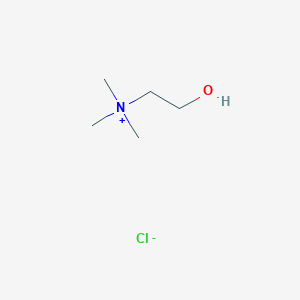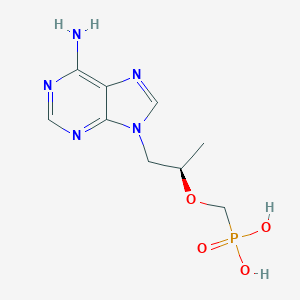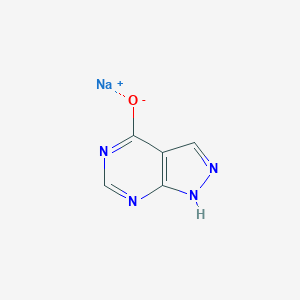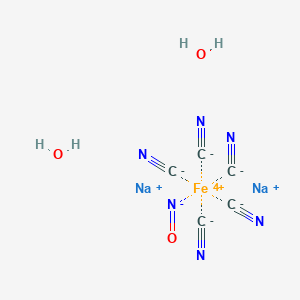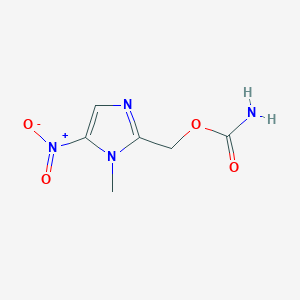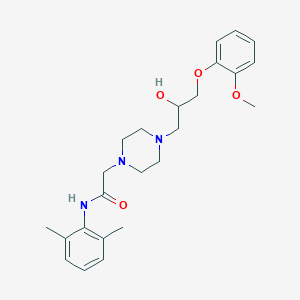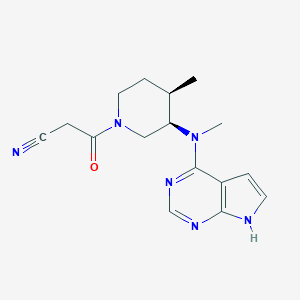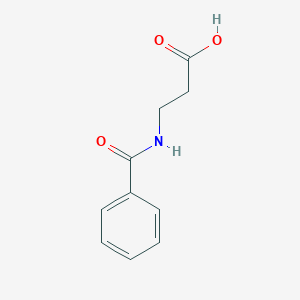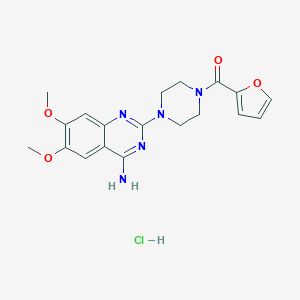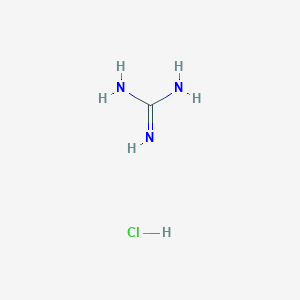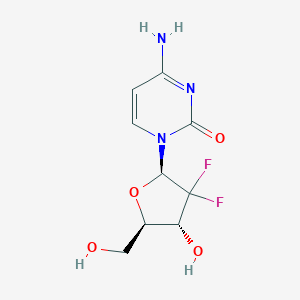
Gemcitabine
Vue d'ensemble
Description
Gemcitabine, known chemically as 2’,2’-difluoro 2’-deoxycytidine, is a nucleoside analog used as a chemotherapy medication. It is primarily employed in the treatment of various carcinomas, including pancreatic, breast, ovarian, and non-small cell lung cancers . This compound works by inhibiting DNA synthesis, thereby preventing cancer cell proliferation and inducing apoptosis .
Mécanisme D'action
Target of Action
Gemcitabine, a nucleoside metabolic inhibitor, primarily targets the DNA synthesis process in cells . It is a cytidine analog, where two fluorine atoms have replaced the hydroxyl on the ribose . The primary targets of this compound are the building blocks of nucleic acids during DNA elongation, which it replaces, thereby arresting tumor growth and promoting apoptosis of malignant cells .
Mode of Action
This compound, as a prodrug, is transformed into its active metabolites inside the cell . These metabolites work by replacing the building blocks of nucleic acids during DNA elongation . This action arrests tumor growth and promotes apoptosis (programmed cell death) of malignant cells . The structure, metabolism, and mechanism of action of this compound are similar to cytarabine, but this compound has a wider spectrum of antitumor activity .
Biochemical Pathways
This compound interferes with the DNA synthesis by incorporating into elongating DNA, and indirectly interferes with DNA replication by inhibiting the nucleoside salvage pathway . After being transported into the cell, this compound is phosphorylated by deoxycytidine kinase to form this compound monophosphate, which is then converted to the active compounds, this compound diphosphate and this compound triphosphate . These active forms inhibit processes required for DNA synthesis .
Pharmacokinetics
This compound is a hydrophilic molecule, and its uptake into cells is mediated by three nucleoside transporters: SLC29A1, SLC28A1, and SLC28A3 . After administration and uptake by the cancer cell, this compound undergoes an initial phosphorylation by deoxycytidine kinase and to a lower extent by the extra-mitochondrial thymidine kinase 2, followed by a series of phosphorylation steps in order to be incorporated into both DNA and RNA as its active phosphorylated form this compound triphosphate .
Result of Action
The result of this compound’s action is the inhibition of DNA synthesis, which results in cell death . After the incorporation of this compound nucleotide on the end of the elongating DNA strand, one more deoxynucleotide is added and thereafter, the DNA polymerases are unable to proceed . This irreparable error leads to inhibition of DNA synthesis, and eventually apoptosis .
Action Environment
The action of this compound can be influenced by various environmental factors. For instance, the presence of certain membrane transporters, activating and inactivating enzymes at the tumor level, or the Hedgehog signaling pathway can affect the efficacy of this compound . Furthermore, genetic polymorphisms affecting cytidine deaminase, the enzyme responsible for the liver disposition of this compound, could act as a marker for clinical outcome (i.e., toxicity, efficacy) .
Applications De Recherche Scientifique
Gemcitabine has a wide range of applications in scientific research:
Analyse Biochimique
Biochemical Properties
Gemcitabine is a cytidine analog with two fluorine atoms replacing the hydroxyl on the ribose . As a prodrug, this compound is transformed into its active metabolites that work by replacing the building blocks of nucleic acids during DNA elongation, arresting tumor growth, and promoting apoptosis of malignant cells . The structure, metabolism, and mechanism of action of this compound are similar to cytarabine, but this compound has a wider spectrum of antitumor activity .
Cellular Effects
This compound exerts its effects on various types of cells and cellular processes. It has been shown to enhance the immunogenicity of lung cancer by increasing the exposure of calreticulin, high mobility group box 1, and upregulating expression of NKG2D ligands . It also increases expression of IFN-γ while high-dose this compound treatment impairs NK-cell proliferation .
Molecular Mechanism
This compound works by blocking the creation of new DNA, which results in cell death . Once transported into the cell, it must be phosphorylated by deoxycytidine kinase to an active form . Both this compound diphosphate and this compound triphosphate inhibit processes required for DNA synthesis . Incorporation of this compound into DNA is most likely the major mechanism by which this compound causes cell death .
Temporal Effects in Laboratory Settings
This compound’s effects change over time in laboratory settings. For example, in a study involving pancreatic cell lines, sequence-dependent effects of the combination of thymidylate synthase inhibitors and this compound were seen with maximum effect when the inhibitors preceded this compound .
Dosage Effects in Animal Models
The effects of this compound vary with different dosages in animal models. For instance, in a study involving Swiss mice, this compound was administered in a daily schedule for a month, at increasing doses of 1, 2, and 5 mg/kg .
Metabolic Pathways
This compound is involved in several metabolic pathways. It is a pro-drug and, once transported into the cell, must be phosphorylated by deoxycytidine kinase to an active form . Both this compound diphosphate and this compound triphosphate inhibit processes required for DNA synthesis .
Transport and Distribution
This compound is transported into cells by nucleoside transporters . Once inside the cell, it undergoes an initial phosphorylation by deoxycytidine kinase, followed by a series of phosphorylation steps to be incorporated into both DNA and RNA as its active phosphorylated form .
Subcellular Localization
This compound, once transported into the cell, undergoes a series of transformations to become its active form. This process occurs within the cell, indicating that this compound’s subcellular localization is within the cell’s cytoplasm .
Méthodes De Préparation
Synthetic Routes and Reaction Conditions: The synthesis of gemcitabine involves multiple steps, starting from cytosine. One common method includes the preparation of 2-deoxy-D-erythro-2,2-difluoro-ribofuranose-3,5-dibenzoate, followed by its coupling with a silyl-ether protecting group . The reaction conditions typically involve the use of hexamethyldisilazane and hydrochloric acid for the final product formation .
Industrial Production Methods: Industrial production of this compound hydrochloride often involves the reduction of 2-deoxy-D-erythro-2,2-difluoro-ribofuranose protected at the hydroxyls at the 3- and 5-positions with diisobutyl-aluminium hydride in toluene (DIBAL) . The final purification is achieved through chromatography and crystallization techniques to meet pharmacopoeia standards .
Analyse Des Réactions Chimiques
Types of Reactions: Gemcitabine undergoes various chemical reactions, including:
Oxidation and Reduction: These reactions are crucial in the metabolic pathways of this compound within the body.
Substitution Reactions: this compound can participate in nucleophilic substitution reactions due to its nucleoside structure.
Common Reagents and Conditions:
Oxidation: Often involves the use of oxidizing agents like hydrogen peroxide.
Reduction: Typically employs reducing agents such as sodium borohydride.
Substitution: Conditions may include the use of bases like sodium hydroxide.
Major Products: The primary products formed from these reactions are various metabolites of this compound, which play a role in its pharmacokinetics and pharmacodynamics .
Comparaison Avec Des Composés Similaires
Cytarabine: Another nucleoside analog with a similar mechanism of action but a narrower spectrum of activity.
Fluorouracil: A pyrimidine analog used in chemotherapy, differing in its metabolic pathway and target specificity.
Capecitabine: An oral prodrug of fluorouracil with similar applications but different pharmacokinetics.
Uniqueness of Gemcitabine: this compound’s unique feature lies in its dual fluorine substitution, which enhances its stability and efficacy compared to other nucleoside analogs . This structural modification allows for a broader range of applications and improved therapeutic outcomes .
Propriétés
IUPAC Name |
4-amino-1-[(2R,4R,5R)-3,3-difluoro-4-hydroxy-5-(hydroxymethyl)oxolan-2-yl]pyrimidin-2-one;hydrochloride | |
|---|---|---|
| Source | PubChem | |
| URL | https://pubchem.ncbi.nlm.nih.gov | |
| Description | Data deposited in or computed by PubChem | |
InChI |
InChI=1S/C9H11F2N3O4.ClH/c10-9(11)6(16)4(3-15)18-7(9)14-2-1-5(12)13-8(14)17;/h1-2,4,6-7,15-16H,3H2,(H2,12,13,17);1H/t4-,6-,7-;/m1./s1 | |
| Source | PubChem | |
| URL | https://pubchem.ncbi.nlm.nih.gov | |
| Description | Data deposited in or computed by PubChem | |
InChI Key |
OKKDEIYWILRZIA-OSZBKLCCSA-N | |
| Source | PubChem | |
| URL | https://pubchem.ncbi.nlm.nih.gov | |
| Description | Data deposited in or computed by PubChem | |
Canonical SMILES |
C1=CN(C(=O)N=C1N)C2C(C(C(O2)CO)O)(F)F.Cl | |
| Source | PubChem | |
| URL | https://pubchem.ncbi.nlm.nih.gov | |
| Description | Data deposited in or computed by PubChem | |
Isomeric SMILES |
C1=CN(C(=O)N=C1N)[C@H]2C([C@@H]([C@H](O2)CO)O)(F)F.Cl | |
| Source | PubChem | |
| URL | https://pubchem.ncbi.nlm.nih.gov | |
| Description | Data deposited in or computed by PubChem | |
Molecular Formula |
C9H12ClF2N3O4 | |
| Source | PubChem | |
| URL | https://pubchem.ncbi.nlm.nih.gov | |
| Description | Data deposited in or computed by PubChem | |
Related CAS |
95058-81-4, 103882-84-4 | |
| Record name | Gemcitabine hydrochloride [USAN:USP] | |
| Source | ChemIDplus | |
| URL | https://pubchem.ncbi.nlm.nih.gov/substance/?source=chemidplus&sourceid=0122111039 | |
| Description | ChemIDplus is a free, web search system that provides access to the structure and nomenclature authority files used for the identification of chemical substances cited in National Library of Medicine (NLM) databases, including the TOXNET system. | |
DSSTOX Substance ID |
DTXSID3047849 | |
| Record name | 2'-Deoxy-2',2'-difluorocytidine monohydrochloride | |
| Source | EPA DSSTox | |
| URL | https://comptox.epa.gov/dashboard/DTXSID3047849 | |
| Description | DSSTox provides a high quality public chemistry resource for supporting improved predictive toxicology. | |
Molecular Weight |
299.66 g/mol | |
| Source | PubChem | |
| URL | https://pubchem.ncbi.nlm.nih.gov | |
| Description | Data deposited in or computed by PubChem | |
CAS No. |
122111-03-9 | |
| Record name | Gemcitabine hydrochloride | |
| Source | CAS Common Chemistry | |
| URL | https://commonchemistry.cas.org/detail?cas_rn=122111-03-9 | |
| Description | CAS Common Chemistry is an open community resource for accessing chemical information. Nearly 500,000 chemical substances from CAS REGISTRY cover areas of community interest, including common and frequently regulated chemicals, and those relevant to high school and undergraduate chemistry classes. This chemical information, curated by our expert scientists, is provided in alignment with our mission as a division of the American Chemical Society. | |
| Explanation | The data from CAS Common Chemistry is provided under a CC-BY-NC 4.0 license, unless otherwise stated. | |
| Record name | Gemcitabine hydrochloride [USAN:USP] | |
| Source | ChemIDplus | |
| URL | https://pubchem.ncbi.nlm.nih.gov/substance/?source=chemidplus&sourceid=0122111039 | |
| Description | ChemIDplus is a free, web search system that provides access to the structure and nomenclature authority files used for the identification of chemical substances cited in National Library of Medicine (NLM) databases, including the TOXNET system. | |
| Record name | 2'-Deoxy-2',2'-difluorocytidine monohydrochloride | |
| Source | EPA DSSTox | |
| URL | https://comptox.epa.gov/dashboard/DTXSID3047849 | |
| Description | DSSTox provides a high quality public chemistry resource for supporting improved predictive toxicology. | |
| Record name | Cytidine, 2'-deoxy-2',2'-difluoro-, hydrochloride (1:1) | |
| Source | European Chemicals Agency (ECHA) | |
| URL | https://echa.europa.eu/substance-information/-/substanceinfo/100.108.693 | |
| Description | The European Chemicals Agency (ECHA) is an agency of the European Union which is the driving force among regulatory authorities in implementing the EU's groundbreaking chemicals legislation for the benefit of human health and the environment as well as for innovation and competitiveness. | |
| Explanation | Use of the information, documents and data from the ECHA website is subject to the terms and conditions of this Legal Notice, and subject to other binding limitations provided for under applicable law, the information, documents and data made available on the ECHA website may be reproduced, distributed and/or used, totally or in part, for non-commercial purposes provided that ECHA is acknowledged as the source: "Source: European Chemicals Agency, http://echa.europa.eu/". Such acknowledgement must be included in each copy of the material. ECHA permits and encourages organisations and individuals to create links to the ECHA website under the following cumulative conditions: Links can only be made to webpages that provide a link to the Legal Notice page. | |
| Record name | GEMCITABINE HYDROCHLORIDE | |
| Source | FDA Global Substance Registration System (GSRS) | |
| URL | https://gsrs.ncats.nih.gov/ginas/app/beta/substances/U347PV74IL | |
| Description | The FDA Global Substance Registration System (GSRS) enables the efficient and accurate exchange of information on what substances are in regulated products. Instead of relying on names, which vary across regulatory domains, countries, and regions, the GSRS knowledge base makes it possible for substances to be defined by standardized, scientific descriptions. | |
| Explanation | Unless otherwise noted, the contents of the FDA website (www.fda.gov), both text and graphics, are not copyrighted. They are in the public domain and may be republished, reprinted and otherwise used freely by anyone without the need to obtain permission from FDA. Credit to the U.S. Food and Drug Administration as the source is appreciated but not required. | |
Retrosynthesis Analysis
AI-Powered Synthesis Planning: Our tool employs the Template_relevance Pistachio, Template_relevance Bkms_metabolic, Template_relevance Pistachio_ringbreaker, Template_relevance Reaxys, Template_relevance Reaxys_biocatalysis model, leveraging a vast database of chemical reactions to predict feasible synthetic routes.
One-Step Synthesis Focus: Specifically designed for one-step synthesis, it provides concise and direct routes for your target compounds, streamlining the synthesis process.
Accurate Predictions: Utilizing the extensive PISTACHIO, BKMS_METABOLIC, PISTACHIO_RINGBREAKER, REAXYS, REAXYS_BIOCATALYSIS database, our tool offers high-accuracy predictions, reflecting the latest in chemical research and data.
Strategy Settings
| Precursor scoring | Relevance Heuristic |
|---|---|
| Min. plausibility | 0.01 |
| Model | Template_relevance |
| Template Set | Pistachio/Bkms_metabolic/Pistachio_ringbreaker/Reaxys/Reaxys_biocatalysis |
| Top-N result to add to graph | 6 |
Feasible Synthetic Routes
Avertissement et informations sur les produits de recherche in vitro
Veuillez noter que tous les articles et informations sur les produits présentés sur BenchChem sont destinés uniquement à des fins informatives. Les produits disponibles à l'achat sur BenchChem sont spécifiquement conçus pour des études in vitro, qui sont réalisées en dehors des organismes vivants. Les études in vitro, dérivées du terme latin "in verre", impliquent des expériences réalisées dans des environnements de laboratoire contrôlés à l'aide de cellules ou de tissus. Il est important de noter que ces produits ne sont pas classés comme médicaments et n'ont pas reçu l'approbation de la FDA pour la prévention, le traitement ou la guérison de toute condition médicale, affection ou maladie. Nous devons souligner que toute forme d'introduction corporelle de ces produits chez les humains ou les animaux est strictement interdite par la loi. Il est essentiel de respecter ces directives pour assurer la conformité aux normes légales et éthiques en matière de recherche et d'expérimentation.


